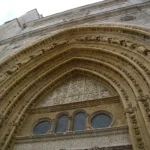St. Peter’s Basilica stands at the heart of Vatican City as a testament to faith, artistry, and architectural ingenuity. This monumental cathedral, with its vast dome and intricate details, draws visitors worldwide eager to witness its grandeur and history. Whether arriving from Rome’s bustling center or nearby airports, travelers find themselves stepping into a space where spiritual significance and human creativity intertwine. This guide navigates the basilica’s architectural marvels, practical visiting details, and nearby amenities to enrich your journey.
Table of Contents
Accessing the Basilica: Navigating Vatican City’s Heart
Located within the tiny enclave of Vatican City, St. Peter’s Basilica is most easily reached from Rome, a city rich in transport connections. If you are coming from Rome’s main train station, Termini, the Metro Line A towards Battistini will get you to Ottaviano-San Pietro station in about 10 minutes. From there, it is a pleasant 10-minute walk southward through historic streets to the basilica’s entrance.
Travelers arriving by air can use Rome’s Fiumicino Airport. Shuttle buses or taxis to central Rome connect with the metro system, or a direct taxi to Vatican City takes about 40 minutes depending on traffic. For those preferring bus transport, lines 40 or 62 from central Rome serve Vatican stops close to the basilica.
For accommodation, numerous guesthouses and boutique lodgings surround the Vatican walls and the Prati district, providing a convenient base. Dining nearby offers delightful Roman trattorias and cafes where you can savor classic dishes such as saltimbocca alla romana or carciofi alla giudia accompanied by a glass of robust Italian wine.
Architectural Brilliance and Historical Roots of St. Peter’s
St. Peter’s Basilica is not just a church; it is a monumental narrative of Renaissance and Baroque architecture. Constructed over more than a century, from 1506 to 1626, it replaced the original Constantinian basilica built in the 4th century on what was believed to be the burial site of Saint Peter, one of Jesus’ apostles and the first Pope.
The basilica’s design involves contributions from some of history’s greatest architects, including Bramante, Michelangelo, Raphael, and Bernini. Michelangelo’s dome, a towering symbol visible across Rome, is a marvel of engineering and aesthetic balance, inspired by the Pantheon but evolved into a masterpiece that commands the skyline.
The interior boasts a harmonious blend of sculpture, mosaics, and architecture. Bernini’s grand baldachin, a bronze canopy over the papal altar, exemplifies Baroque dynamism with twisting columns and expressive details. The basilica also houses Michelangelo’s Pietà, a poignant marble sculpture capturing serene sorrow and divine compassion.
Planning Your Visit: Timing, Tours, and Entrance Tips
To fully appreciate St. Peter’s Basilica, timing can make a difference. The basilica opens daily from early morning until evening, but early mornings on weekdays are less crowded and offer a more contemplative atmosphere. Sundays and religious holidays see large crowds and special ceremonies that may limit access.
Visitors should note that entry to the basilica itself is free, though lines can be long, especially in peak tourist seasons like spring and autumn. To avoid waits, booking a guided tour or skip-the-line tickets is highly recommended. These guided experiences provide deeper insight into the basilica’s art and history, often including access to areas not open to general admission, such as the dome or the Vatican grottoes.
Reservations are advised for the dome climb, a physically demanding but rewarding ascent offering panoramic views over Vatican City and Rome. Tickets for this climb are available on the official Vatican website.
Unexpected Details and Stories Within the Basilica
Beyond the grand scale, St. Peter’s Basilica contains fascinating details that often escape casual observation. For instance, near the entrance, the “Holy Door” is ceremonially opened only during Jubilee years, a tradition symbolizing spiritual renewal. The floor mosaics, often overlooked, reveal intricate maps and religious symbols dating back centuries.
Many visitors to St. Peter’s Basilica enjoy extending their journey to Venice, where the city’s unique canals and historic charm offer a beautifully different glimpse of Italian culture through its stunning art and waterways. Venice travel highlights provide a perfect complement to your Vatican visit.
Another intriguing feature is the statue of St. Peter himself, whose bronze foot is worn smooth by centuries of pilgrims touching or kissing it for blessings-a tangible link between past and present visitors.
Nearby Attractions and Enjoying Vatican City Beyond the Basilica
After absorbing the basilica’s majesty, consider a stroll through St. Peter’s Square, designed by Bernini to create a welcoming embrace with towering colonnades symbolizing the church’s reach. The Vatican Museums, home to the Sistine Chapel with Michelangelo’s iconic ceiling, are just a short walk away and offer an extensive collection of art and artifacts.
Nearby streets feature charming cafes and gelato shops where you can unwind. The Vatican Gardens, accessible only through guided tours, provide serene green spaces contrasting the architectural density of the basilica and museums.
Not far from St. Peter’s Basilica, the Sistine Chapel invites you into an artistic sanctuary where Michelangelo’s masterpieces reveal deeper layers of spiritual beauty.
Official Resources for a Smooth Visit
For current information on opening hours, ticketing, and special events, the official Vatican website is the most reliable source. You can plan your visit, book tours, and find updates directly at the official site for St. Peter’s Basilica.
After admiring St. Peter’s Basilica, many enjoy wandering through the rich collection showcased at the Vatican Museums, where art and history fill the halls within the same sacred city-state.
Using this site ensures you receive accurate and updated details about required visitor protocols, especially during special religious celebrations or security changes.

